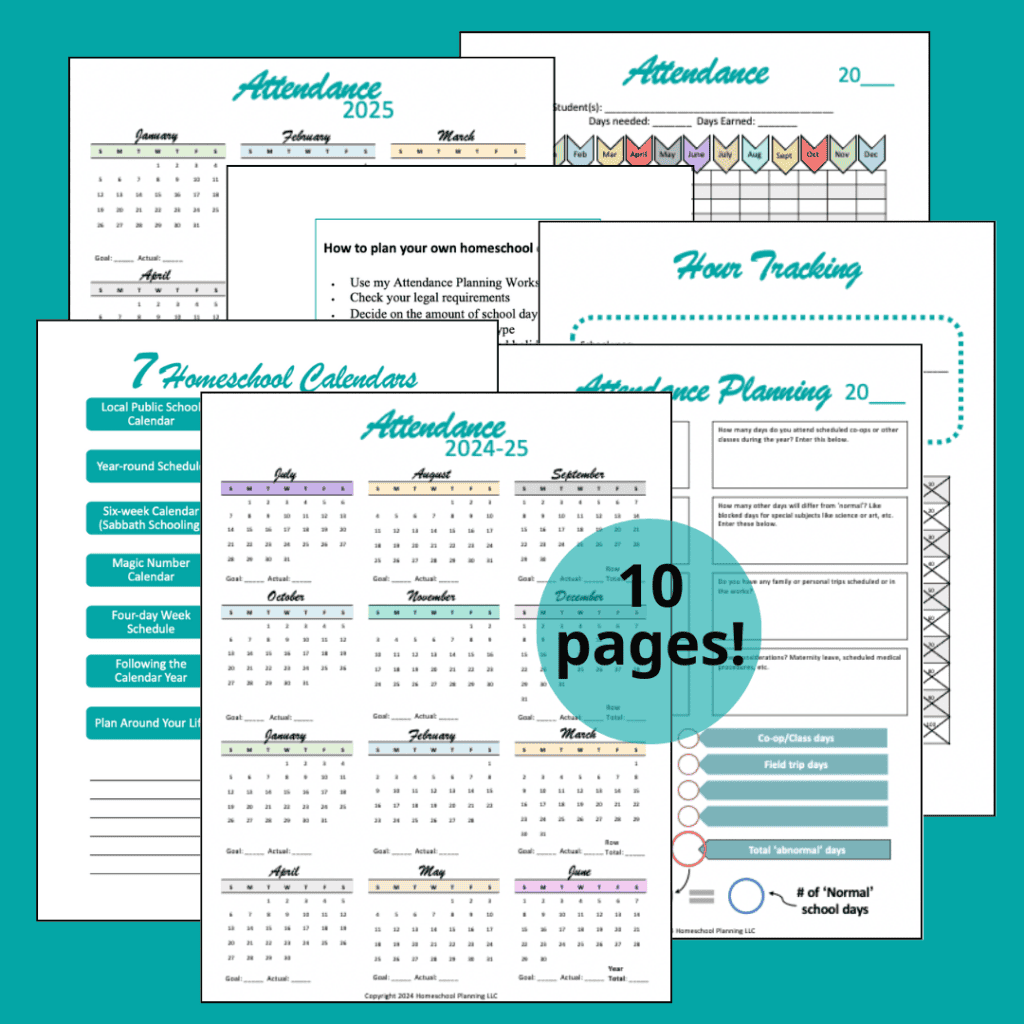Do you like puzzles? I hope you do! Creating your own personalized annual homeschool calendars is a lot like doing a puzzle! You have the school days, the number of weeks of school, as well as the vacation days all to find a way to fit together.
The joy of homeschooling though is that there is no one way this puzzle has to fit together! You can design it to fit your needs and lifestyle. This brings so much freedom to your life.
Whether you prefer a year-round schedule or one that follows the traditional academic calendar, there are several types of homeschool calendars to consider. In this article, we’ll explore seven different types of homeschool calendars and how they can help you schedule your year.
*Note: This post contains affiliate links, which means I receive a small commission, at no extra cost to you, if you make a purchase using the link. Please see my disclosure for more details.

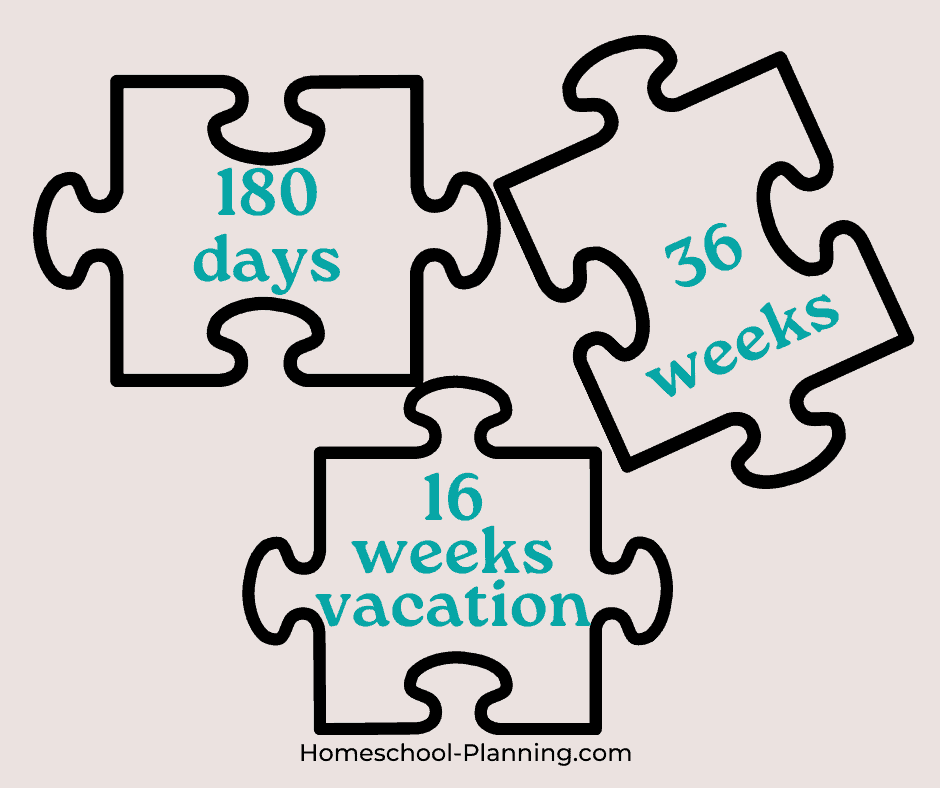
7 Types of Homeschool Calendars
Many states require around 180 days of school for homeschoolers. Some more, some less. But we’ll use it for an example.
This can be broken down into 36 weeks of school each year and 16 weeks off. The many ways these puzzle pieces fit together can be both intimidating and liberating.
As homeschoolers, we can arrange all these days and weeks however we want! Here are 7 common ways homeschoolers plan out their annual homeschool calendars.
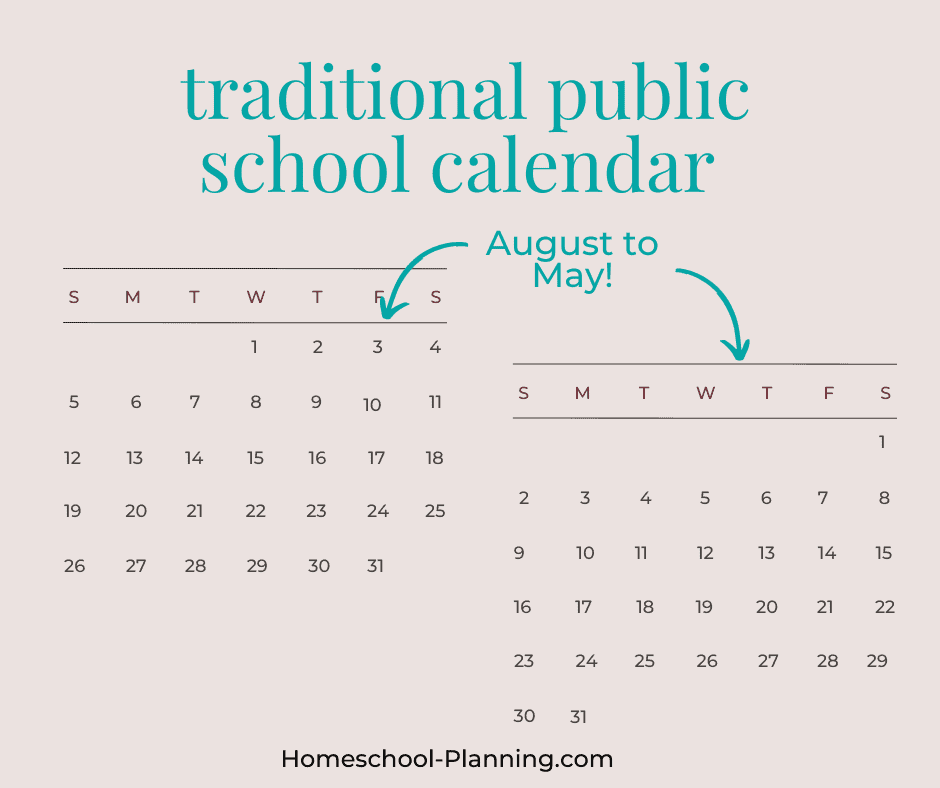
1. Your local public school calendar
Many families will choose to use their local public school calendar as a guide for their own annual homeschool schedule. This can be a convenient option that requires very little thought in advance.
Just get on to your local school system’s website and download their schedule. Do school when they are in school. You are off when they are off. Easy peasy!
This approach to an annual homeschool schedule can be helpful in several ways:
- Easy to be involved with public school activities and sports
- Be on the same schedule as your community
- Easily schedule things with public school friends
- No need to wonder if you got enough days
- Easy to plan – it’s already done!
Cons:
- Harder to take advantage of lower crowds while school is in session
- No freedom to plan around your life
- Take trips when everyone else takes them (more $)
Yep, taking advantage of off-season rates for vacations is easy when you have an alternative school schedule. And visiting museums are nice when the crowds are lower. But field trips should be counted as school days, so this doesn’t have to be a hindrance for you to follow the local school schedule.
Following a traditional school schedule can make it difficult to be flexible with your school days. This can lead you to feel like you have to do make up work if you miss a day.
But homeschoolers have the freedom to be more flexible than that. Using the local school schedule as a starting point to plan out your year can be a great help.
If you want ease in planning out your yearly homeschool calendar, using your local public school calendar makes it pretty simple.

2. Year-round homeschool calendar
Homeschooling year-round is becoming more and more popular among homeschooling families. This approach involves spreading out the required number of school days throughout the year, rather than adhering to a traditional academic calendar with extended summer breaks.
One of the main advantages of homeschooling year-round is that it allows for more frequent breaks, which can help prevent burnout and provide more opportunities for family vacations or travel. It also adds more flexibility for families to adjust their schedules around special events or activities.
Sometimes these breaks are planned in advance, and sometime families will just go with the flow as the year goes on.
Some will plan some longer breaks, while others will take lots of shorter breaks. Or a combo of the two!
Many families that school year round don’t pay too much attention to amount of days for school, grade levels, or “finishing a school year”. They just make school part of their basic family routine year-round. When they finish with one book or level of curriculum, they just start the next one!
This can make for a simplified ease to a lot of the questions of homeschooling.
Pros:
- Frequent breaks
- Adjust school around events
- Make your schedule flexible
- One year flows into the next
Cons:
- No long summer break
- No first/last day of school
- Complicated to fit schedule with public schoolers
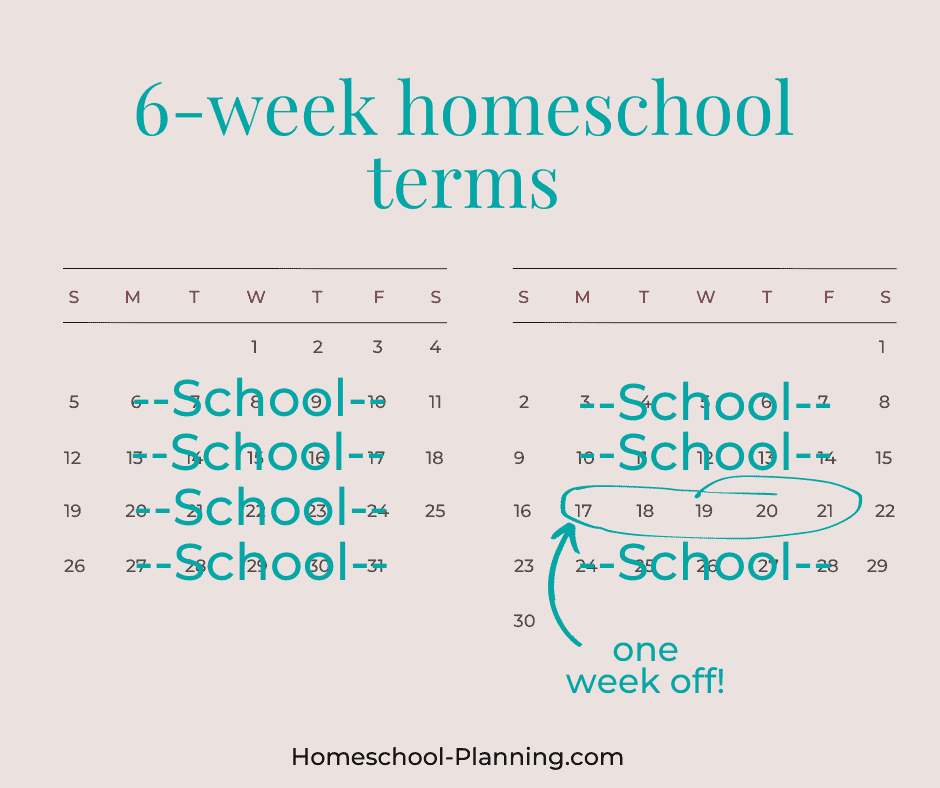
3. Six-week homeschool calendar (Sabbath schooling)
Another popular approach to a homeschool calendar is to use a 6-week homeschool schedule. Some call this Sabbath Schooling, where you work for a 6-week term, then take the 7th week off.
This is called Sabbath Schooling for that reason, that it is similar to the Genesis instruction of resting on the 7th day, just applied to weeks.
This allows families to take a break from the demands of homeschooling and focus on other activities or interests. Many find it helpful to be able to push through a stretch of school knowing there is a good break coming.
Doing this type of homeschool calendar can still give you some considerable breaks. Let’s break down the math for a typical school year of 180 days.
- 180 school days is 36 weeks of school
- 52 weeks in a year
- 52-36=16 weeks off school
- Six groups of 6-week school terms
- Each term is followed by at least 1 week off
- Still leaves 10 weeks off to schedule!
- You could take a whole month off at Christmas
- You could take a whole month off in the summer
- So many options!
Pros:
- Frequent breaks
- Easy to schedule large projects or trips
- Include religious observance in your schedule
- Prevent burnout
Cons:
- Requires consistency when in school
- Can only take breaks during break weeks

4. Magic number calendar
A “magic number” homeschool calendar is likely the most flexible of annual homeschool schedules. The basic idea is to find your minimum number of days – your magic number – that you must do school each month. Schedule them however you desire and once you have met that number, schooling for that month is finished.
I heard about this brilliant idea from Pam Barnhill years ago and have used it ever since. I have found it very freeing as I struggle with sticking to a pre-determined schedule.
A little more about how it works. If you need 180 days in your school year and want to homeschool for only 10 months a year, you would divide 180 by 10. Answer is 18. So for each of those 10 months in your school year, you need to do 18 days of school.
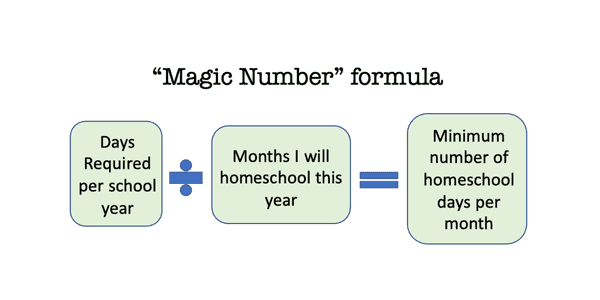
You can squeeze all 18 days into the beginning of the month, or you can spread them out. You can take breaks when you want as long as you get those 18 days in.
Those two months off can be scheduled whenever you like as well. You could decide to take the whole month of December off for the holidays as well as the month of June. Or you do one long break over the summer.
You could also school for 11 months, or even 9. You could even homeschool more or less than that number in one month if needed, you would just need to adjust the numbers elsewhere to get them all.
Using this system as a starting point for scheduling your year can be very helpful and freeing.
Pros:
- Easy to schedule
- Very flexible
- Take breaks whenever you want
Cons:
- May be too relaxed for some
- Can easily “get behind” if too many breaks
- Requires attention throughout the year
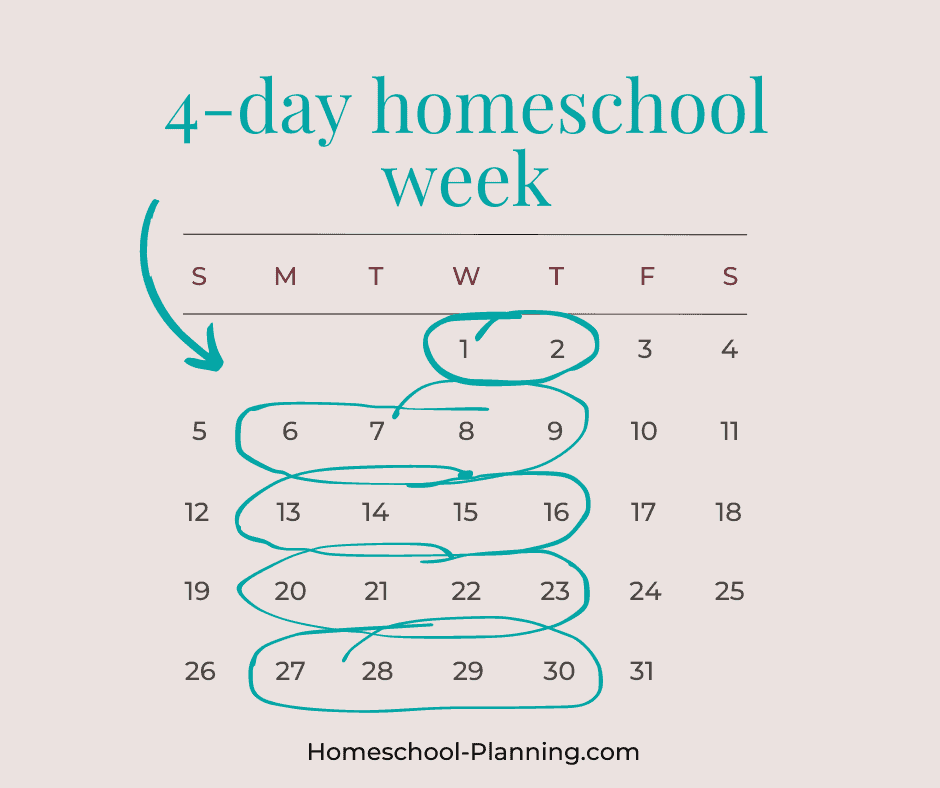
5. Four-day homeschool week calendar
Setting up a 4-day homeschool week schedule can be freeing for many families. This is where you do 4 days of school work each week instead of the typical 5. It has built-in flexibility for other parts of life and homeschooling with frequent short breaks.
Many families will use this fifth day for a regular break from school. With this day, you can complete other house projects, do the shopping, or have a full day of work.
It also could be used for other school activities like field trips and coops. Or a day for kids to do some interest-led learning. In this case, these days can also be counted toward the school day total.
If not using this 5th day as another school day, then schooling 4 days a week for 45 weeks will be a full 180 school days. This will leave you 7 full 5-day weeks off school in addition to the weekly day off.
I like this homeschool calendar because it allows for those bad days when you wake up on the wrong side of the bed. Or for beautiful weather when you just want to go play outside all day. You can easily take a day off without having to rework the schedule or miss a day. It’s already built-in!
Many take Fridays off, but if you’re not a Monday person, you could scrap school on Mondays. Or it could be a different day each week! You could even “save” a day off and combine it with another week for two days off together once in a while.
Pros:
- Built-in margin each week
- Frequent short breaks
- Get extra projects done
Cons:
- Less long breaks

6. Following the calendar year
Following the calendar year for your homeschool calendar involves structuring your school year to align with the traditional January to December calendar.
Somewhere along the timeline, school got arranged to be from August to May with a break in the summer. But starting a new school year with a new calendar in January makes a lot of sense!
Many families struggle doing school work over the holidays in November and December, so starting your year in January can easily allow you to take a longer break during the holidays at the end of the year.
The excitement that a new calendar year brings can only enhance the excitement of a new school year as well.
Other than your start and end dates, following the calendar year for your homeschool schedule isn’t all that different from any of these other schedules. But it makes great logical sense for new beginnings all at once!
Pros:
- Logical breaks with the holidays
- Start the school year and calendar year together
- School through the hot months
- Arrange breaks as desired
Cons:
- Plan the new school year during the holidays
- This calendar is different than much of our culture
- Can be a lot of “new” all at once

7. Plan around your life
Planning around your life isn’t much of a homeschool calendar in itself but more of a way of thinking about your homeschool schedule. The idea is that homeschoolers have the freedom to plan your homeschool calendar around the events in your life. No matter what general calendar you decide to use, it can be adjusted to meet your needs.
You are never at the mercy of another’s schedule other than your own family’s.
If you are expecting a baby this school year, you should definitely take a break from homeschooling for several weeks near the end of your pregnancy and for the initial bonding period. No matter what time of year it is.
If you want to take a family trip in February, do it. If your mother is getting surgery and needs some help, take off school and adjust your calendar.
If you know about an upcoming event far enough in advance, add it to your calendar at the beginning of the year. Schedule the breaks to work with it.
If it’s something that is planned with less notice, you still have the ability to adjust. Count the number of days you have left and decide how to rearrange your schedule to allow for the break.
This may mean a complete reworking of the calendar. Or it may just mean taking an extra break and tacking those days on to the end of the year. You have the right to decide!

How to plan your homeschool calendar
Creating a personalized homeschool calendar allows you to meet the needs of your family and provide a flexible homeschool schedule for your year. It’s pretty easy as well! Just grab a calendar (you can download mine!) and start marking it up.
For more in depth information on planning your year, check out this post about using my free printable homeschool attendance sheets.
I highly suggest you mark up the calendar in pencil or erasable pens. It may take several times over it before you get things nailed down. So print out some extras and keep adjusting until it looks how you want it!
Here are my 11 steps to planning your own homeschool calendar:
- Use my Attendance Planning Worksheet
- Check your legal requirements
- Decide on amount of school days
- Pick your general calendar type
- Cross out extended breaks and holidays
- Mark out scheduled trips
- Consider other planned time off
- Note scheduled classes and field trips
- Pick a first day of school
- Schedule school days
- Choose tentative last day of school
It’s important to remain flexible and adjust your schedule as needed. You may start out at the beginning of the year with this schedule and realize it doesn’t work.
Or maybe something comes up you weren’t expecting. That’s where it is important to be flexible with your homeschool planning! Your calendar is not set in stone. Adjust as needed!
Read: Plan Your Year with Free Printable Homeschool Attendance Sheets
Sample homeschool calendars
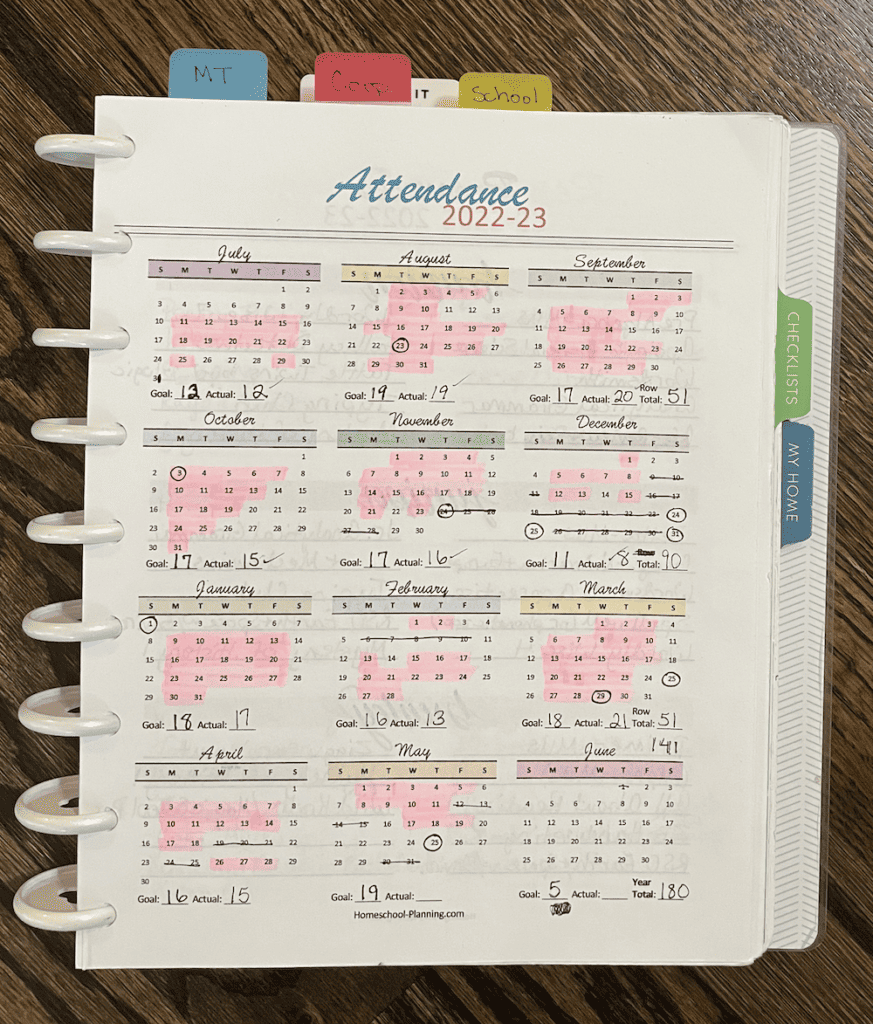
Highlight the days done, cross out planned off days.

Check school days, blackout weekends.
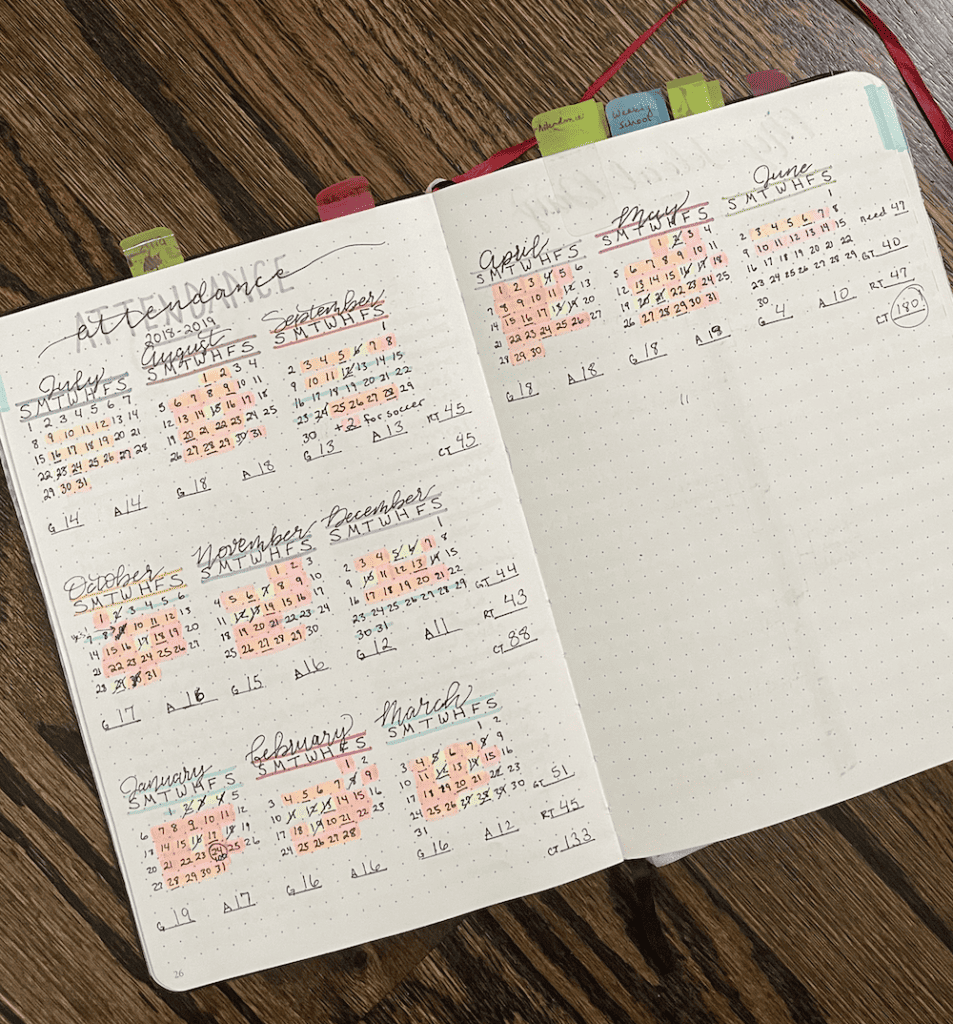
Highlight the days you plan to do as well as the days done.
Free download: homeschool calendars
Looking for some easy worksheets to help guide you through this process? Download my set of Homeschool Calendar worksheets today!
A total of 10 pages to use, there are cheat sheets, guides, and multiple types of calendars to choose from.
Download them, print them out, and use them to plan out your personalized homeschool calendar for this school year!
Closing
Creating your own homeschool calendar is a great step toward planning a successful homeschool year. Whether you opt for a traditional academic calendar, a year-round schedule, or something else, there are plenty of options to choose from. Remember your family’s unique needs when planning your homeschool calendar, and don’t be afraid to adjust as needed throughout the year.
How do you schedule your homeschool calendar? Let me know in the comments below!
Related Posts
The Ultimate Guide to Homeschool Attendance Records
7 Schedule Hacks for your Homeschool
Plan Your Year with Free Printable Homeschool Attendance Sheets










